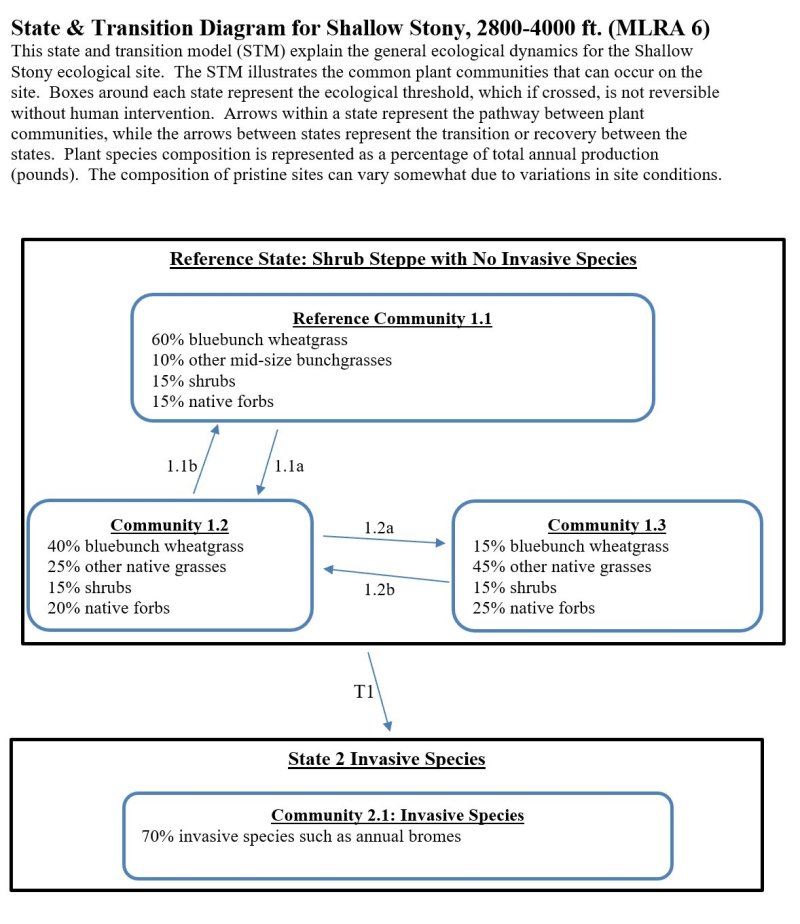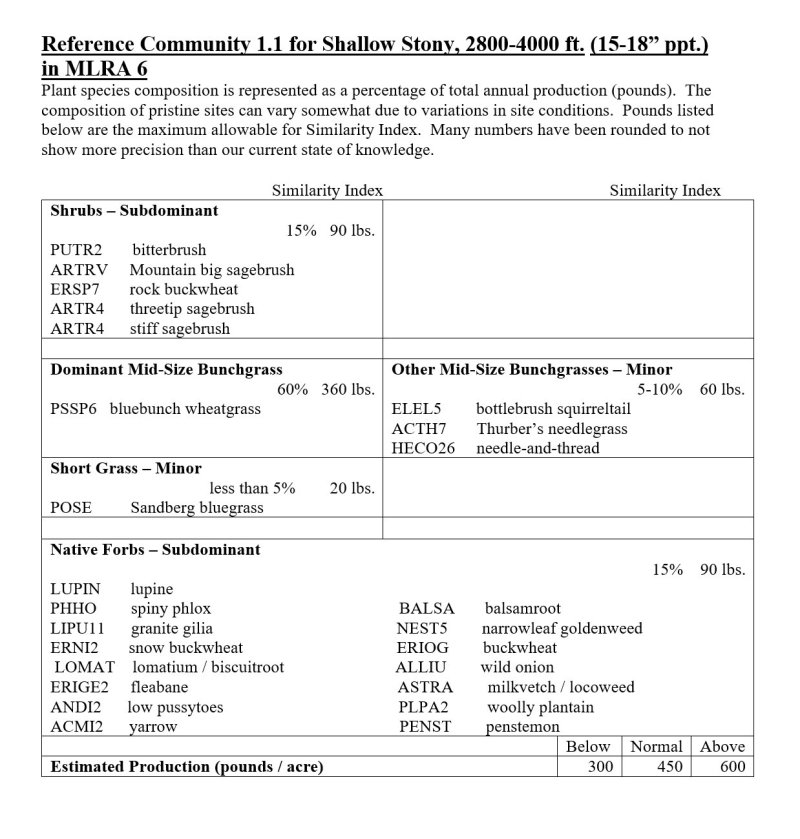Ecological site group R006XG312WA
Shallow Stony, 2800-4000 feet
Last updated: 09/21/2023
Accessed: 12/21/2025
Ecological site group description
Key Characteristics
None specified
Provisional. A provisional ecological site description has undergone quality control and quality assurance review. It contains a working state and transition model and enough information to identify the ecological site.
Physiography
Hierarchical Classification
Major Land Resource Area (MLRA): 6 – Cascade Mountains, East Slope
LRU – Common Resource Areas (CRA):
6.1 – North Cascades Subalpine/Alpine
6.2 – Pasayten/Sawtooth Highlands
6.3 – Okanogan Pine/Fir Hills
6.4 – Chelan Tephra Hills
6.5 – Chiwaukum Hills and Lowlands
For MLRA 6 four ecological site descriptions (ESD) use Shallow Stony in the name:
1. Shallow stony, prairie for the prairies
2. Shallow stony, 2,800 - 4,000 feet
3. Shallow stony, 4,000 – 6,000 feet
4. Shallow stony, 6,000 – 7,600 feet
The ESD below is for Shallow stony, 2800-4000 feet.
Site Concept Narrative:
Diagnostics:
More than 80% of the landscape of MLRA 6 is forest. This site stands out because of a lack of trees.
Shallow Stony, 2,800 – 4,000 feet, is a sparsely vegetated shrub steppe site in the 16-18” precipitation zone. Overstory shrubs are short with bitterbrush, mountain big sagebrush, threetip sagebrush and buckwheat. Bluebunch wheatgrass dominates the reference condition. Thurber’s needlegrass, squirreltail and needle and thread are other grasses. Native forbs fill the interspaces.
Principle Vegetative Drivers:
The shallow soil depth, stones throughout the profile and low elevation, drive the vegetative expression of this site. The soil depth limits deep-rooted species, plus the soil depth and stones limit the water holding capacity in the profile. Due to elevation this site is hotter and drier than the other Shallow Stony site in MLRA 6. Thus, plant production is quite limited for these low elevation Shallow Stony sites.
Influencing Water Features:
A plant’s ability to grow on a site and overall plant production is determined by soil-water-plant relationships
1. Whether rain and melting snow runs off-site or infiltrates into the soil
2. Whether soil condition remain aerobic or become saturated and become anaerobic
3. Water drainage and how quickly the soil reaches wilting point
With adequate cover of live plants and litter, there are no restrictions on this ecological site with water infiltrating into the soil. In some years Shallow Stony sites can become saturated due to the shallow soil depth, but with good drainage would remain anaerobic for only a short period of time. This site has an extremely restricted water holding capacity, so plant production is quite limited.
Physiographic Features:
Most of MLRA 6 is in the Northern and Middle Cascade Mountains. This mountainous area consists of sharp alpine summits with some higher volcanic cones to the west, and lower lying foothills to the east. Strongly sloping mountains and U-shaped valleys are dominant in the north, with eroded basalt plateaus more typical in the south. The East Slope of the Cascades is a transitional area between the moist, rugged Cascade Mountains to the west and the drier, lower lying Columbia Basalt Plateau to the east. MLRA 6 has some of the landforms typical of both mountains and plateaus.
Physiographic Division: Pacific Mountains
Physiographic Province: Cascade-Sierra Mountains
Physiographic Sections: Northern Cascade and Middle Cascade Mountains
Landscapes: Mountains, canyons, plateaus and hills
Landform: Summits, shoulders, sideslopes, footslopes
Elevation: Dominantly 1,100 to 4,400 feet
Central tendency: 2,800 to 4,000 feet
Slope: Total range: 15 to 90 percent
Central tendency: 20 to 60 percent
Aspect: Dominantly on southerly aspect, but occurs on all aspects
Geology:
MLRA 6 consists of Pre-Cretaceous metamorphic rocks cut by younger igneous intrusives. Tilted blocks of marine shale, carbonate, and other sediments occur in the far north, and some younger continental, river-laid sediments occur around Leavenworth, WA. Columbia River basalt is dominant in the southern portion of the state. Alpine glaciation has left remnants of glacial till, debris, and outwash in the northern part of this MLRA.
Climate
The climate across MLRA 6 is characterized by moderately cold, wet winters, and hot, dry summers, with limited precipitation due to the rain shadow effect of the Cascades. The average annual precipitation for most of the East Slope of the Cascades is 16-50 inches. Seventy-five to eighty percent of the precipitation comes late October through March as a mixture of rain and snow. The lowest precipitation occurs along the eastern edge, then increasing with rising elevation to the west. Most of the rainfall occurs as low-intensity, Pacific frontal storms during the winter, spring and fall. Rain turns to snow at the higher elevations. All areas receive snow in winter. Summers are relatively dry. The East Slopes experience greater temperature extremes and receive less precipitation than the west side of the Cascades. The shortest freeze-free periods occur along the western edge and the northern end of this MLRA, which are mountainous. The longest freeze-free periods occur along the Columbia River Gorge.
Mean Annual Precipitation:
Range: 16-24 inches
Central tendency: 16 – 18 inches
Soil moisture regime is xeric
Mean Annual Air Temperature:
Range: 40 to 52 degrees
Central tendency: 44 to 50 degrees
Soil temperature regime is dominantly mesic
Frost-free Period (days):
Total range: 80 to 150
Central tendency: 100 to 130
The growing season is early April through the end of June.
Soil features
Edaphic:
The Shallow Stony, 2,800 – 4,000 feet ecological site commonly occurs with Very Shallow, and Stony Foothills south aspect, bitterbrush, 2800-4000 feet ecological sites.
Representative Soil Features:
This ecological site components are dominantly Lithic and Vitrandic taxonomic subgroups of Haploxerolls great group of the Mollisols. Soils are dominantly shallow. Average available water capacity of about 3.0 inches (7.6 cm) in the 0 to 40 inches (0-100 cm) depth range.
Soil parent material is dominantly loess and volcanic ash mixed with colluvium in the upper part of the soil over colluvium and residuum.
The associated soils are Baldknob, Johntom, Swakane and similar soils.
Dominate soil surface is silt loam to very stony ashy loam.
Dominant particle-size class is loamy-skeletal.
Fragments on surface horizon > 3 inches (% Volume):
Minimum: 0
Maximum: 2
Average: 0
Fragments within surface horizon > 3 inches (% Volume):
Minimum: 0
Maximum: 35
Average: 20
Fragments within surface horizon ≤ 3 inches (% Volume):
Minimum: 0
Maximum: 30
Average: 10
Subsurface fragments > 3 inches (% Volume):
Minimum: 10
Maximum: 50
Average: 30
Subsurface fragments ≤ 3 inches (% Volume):
Minimum: 0
Maximum: 50
Average: 25
Drainage Class: Well drained
Water table depth: Greater than 60 inches
Flooding:
Frequency: None
Ponding:
Frequency: None
Saturated Hydraulic Conductivity Class:
0 to 10 inches: Moderately high and high
10 to 40 inches: Moderately high and high
Depth to root-restricting feature (inches):
Minimum: 10
Maximum: 40
Electrical Conductivity (dS/m):
Minimum: 0
Maximum: 0
Sodium Absorption Ratio:
Minimum: 0
Maximum: 0
Calcium Carbonate Equivalent (percent):
Minimum: 0
Maximum: 0
Soil Reaction (pH) (1:1 Water):
0 - 10 inches: 5.6 to 7.3
10 - 40 inches: 5.6 to 7.8
Available Water Capacity (inches, 0 – 40 inches depth):
Minimum: .7
Maximum: 5.3
Average: 3.0
Vegetation dynamics
Ecological Dynamics:
Shallow Stony, 2800-4000 feet produces about 300-600 pounds/acre of biomass annually.
Bluebunch wheatgrass, bitterbrush is at the core of the Shallow Stony 2800 – 4000 ft. ecological site and warrants a degree of understanding. This perennial is a long-lived, mid-sized bunchgrass with an awned or awnless inflorescence arranged in a spike. Bluebunch provides a crucial and extensive network of roots to the upper portions (up to 48” deep in soils with no root-restrictive horizons) of the soil profile. These roots create a massive underground source to stabilize the soils, provide organic matter and nutrients inputs, and help maintain soil pore space for water infiltration and water retention in the soil profile. The extensive rooting system of mid-sized bunchgrasses leaves very little soil niche space available for invasion by other species. This drought resistant root can compete with, and suppress, the spread of exotic weeds.
The elevation range for this ecological site (2800-4000 feet) is the lowest elevation for mountain big sagebrush and the upper elevation for threetip sagebrush. Threetip sagebrush is confined mainly to the hottest and driest portions of this elevation range. Whereas Idaho fescue may be found on east, west and north aspects but not on south facing slopes.
The stability and resiliency of the reference communities is directly linked to the health and vigor of the entire plant community. Research has found, on similar rangeland, that communities remain resistant to medusahead if sites maintain at least 0.8 mid-sized bunchgrass plant/sq. ft. (K. Davies, 2008).
Shallow Stony is resistant to most natural disturbances and ecologically stable. Due to 35-75% surface rocks and limited forage, this ecological site is not attractive to grazing animals and so is rarely if ever grazed. The vegetative cover is too low to carry fire, so these sites rarely burn. Based on inherent protection from both fire and grazing, most Shallow Stony sites are stable.
However, if this site does experience a major disturbance it is not resilient and may be extremely difficult to stabilize once altered. For example, vehicle traffic when the soil is saturated will leave ruts that remain for years to come.
For more grazing management information refer to Range Technical Notes found in Section I Reference Lists of NRCS Field Office Technical Guide for Washington State.
In Washington, bluebunch wheatgrass communities provide habitat for a variety of upland wildlife species.
Supporting Information :
Associated Sites:
Shallow Stony 2800 – 4000 ft. is associated with other ecological sites in MLRA 6 including Stony Foothills South Aspect 2800-4000 feet, Very Shallow and ponderosa pine sites.
Similar Sites:
Ecological sites similar to Shallow Stony 2800 – 4000 ft.:
Shallow Stony, 4000-6000 feet in MLRA 6
Shallow Stony, 6000-7600 feet is MLRA 6
Shallow Stony, Prairie in MLRA 6
Shallow Stony in sagebrush steppe region of MLRA 8
Shallow Stony on south side of Columbia Hills in MLRA 8
Inventory Data References (narrative):
Data to populate Reference Community came from several sources: (1) NRCS ecological sites from 2004, (2) Soil Conservation Service range sites from 1980s and 1990s, (3) Daubenmire’s habitat types, and (4) ecological systems from Natural Heritage Program
Major Land Resource Area
MLRA 006X
Cascade Mountains, Eastern Slope
Stage
Provisional
Contributors
Provisional Site Author: Kevin Guinn Technical Team: W. Keller, K. Paup-Lefferts, R. Fleenor, K. Bomberger
Click on box and path labels to scroll to the respective text.

